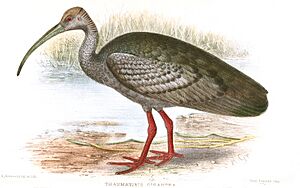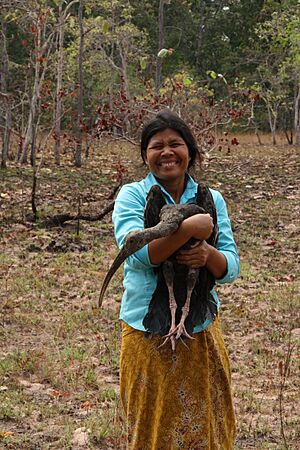Giant ibis facts for kids
Quick facts for kids Giant ibis |
|
|---|---|
 |
|
| Conservation status | |
| Scientific classification | |
| Synonyms | |
|
Thaumatibis gigantea (Oustalet, 1877) |
The giant ibis (Pseudibis gigantea) is a very large wading bird from the ibis family. It lives mostly in northern Cambodia. A few can also be found in southern Laos and sometimes in Vietnam. It's known for being the biggest ibis species alive today.
Contents
About the Giant Ibis
True to its name, the giant ibis is the largest type of ibis in the world. Adult birds are about 102 to 106 centimeters (40 to 42 inches) long. They weigh around 4.2 kilograms (9.3 pounds).
Appearance
These birds have dark grayish-brown feathers. Their head and upper neck are bare and grey. They have dark bands on the back of their head and shoulders. Their wing tips are pale silvery-grey with black stripes. The beak is yellowish-brown, their legs are orange, and their eyes are dark red.
Young ibises have short black feathers on the back of their head and neck. They also have shorter beaks and brown eyes.
Sounds They Make
The giant ibis has a loud, ringing call. It often repeats this call around sunrise or sunset. The sound is described as a-leurk a-leurk.
Where They Live
The giant ibis is a bird that lives in lowland areas. You can find them in marshes, swamps, and near lakes. They also live near wide rivers, flooded plains, and in semi-open forests. They like pools, ponds, and seasonal wet meadows in thicker deciduous forests.
Past and Present Homes
In the past, giant ibises lived in eastern Thailand, central and northern Cambodia, southern Laos, and southern Vietnam. They were quite common in the Mekong Delta until the 1920s. Now, there are very few left. A small group still lives in Cambodia, southern Laos, and possibly Vietnam.
Life and Habits
What They Eat
The giant ibis eats small water animals without backbones. These include eels, crustaceans, and small amphibians like frogs. They also eat small reptiles. Insects like locusts and cicadas are a regular part of their diet when there are many around. Sometimes, they also eat seeds.
Outside of the time they are raising young, frogs and mole-crickets are very important foods. They mostly look for food in muddy, shallow water. However, they can feed in all depths of water in seasonal forest pools. Sometimes, giant ibises feed in small groups. These groups might be a breeding pair or a small family. They have even been seen feeding with black ibises.
Reproduction and Family Life
Not much is known about how giant ibises raise their young. They build nests in trees. They might prefer Dipterocarpus trees. Their nests are usually at least 4 kilometers (2.5 miles) away from places where people live. These birds are not usually scared of humans unless they are bothered or hunted a lot.
Female ibises lay two eggs. This happens at the start of the rainy season, usually from June to September. Earthworms found in wet grasslands seem to be an important food for baby ibises. Giant ibises usually stay in one area. However, they can travel far to find food or if they are disturbed. They often stay with their family group all year. In the dry season, when they are not nesting, groups of up to seven ibises have been seen feeding together.
Why They Are Endangered
The giant ibis is listed as Critically Endangered on the IUCN Red List. This means they are very close to disappearing forever.
Main Threats
The biggest problems for the giant ibis are:
- Habitat Loss: Wetlands are drained for farming. Forests are cut down to grow rubber, cassava, or trees for wood pulp.
- Human Activity: More people in Cambodia means more disturbance and less lowland forest.
- Hunting: People sometimes hunt ibises for meat.
- Predators: Eggs can be eaten by animals like the Asian palm civet and the yellow-throated marten. The ibis cannot survive if too many eggs are eaten.
- Climate Change: Local droughts, possibly linked to global climate change, can harm their breeding areas.
Conservation Efforts
Some people are working to help the giant ibis. They protect nests by putting metal belts on trees. These belts stop predators from reaching the eggs. However, protecting their homes and dealing with more people in Cambodia is still a big challenge.
It is important to increase ecotourism in the area. Also, educating local people is key to helping the species recover. Experts believe there are fewer than 500 giant ibises left in total. This includes young birds. In 2018, the IUCN said there were less than 200 adult ibises.



